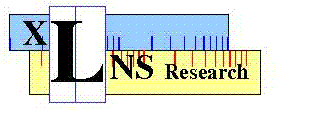XLNS Research

|
XLNS Research
|
|
XLNS Home |
Applications Areas for XLNS Research Logarithmic Number Systems (LNS)The Logarithmic Number System (LNS) transforms complicated problems with multiplication, division and roots to simple integer operations. Verilog DesignOur Verilog design methodology is described in Verilog Digital Computer Design published by Prentice Hall. For example, with these techniques we developed a clean-room clone, which we call the AWE, of a simple (and very popular) 32-bit RISC microprocessor. One-Hot State MachinesThe one-hot approach represents every state with a separate bit (e.g., 0001, 0010, 0100 and 1000) , instead of more complicated state mappings (e.g., 00, 01, 10 and 11) where the meaning cannot be decerned from a single bit. We develop tools to synthesize and simulate verilog into one-hot state machines, e.g., VITO, VITOCUDA. We also are developing a Field Programmable One-Hot Array (FPOHA), which in some contexts appears to be very competitive with FPGAs, even though its architecture is very simple. MicrorobotsFull-size robots (100cm and above) typically have complicated hardware/software to enable autonomous, on-board control. In contrast, Micro Electro Mechanical Systems (MEMS) microrobots (say 200 microns) are so small that they have typically have required external control. Concepts mentioned above that we specialize in, such as one-hot state machines, enable autonomous microrobot control. For example, a simple one-hot state machine lets microrobots dock using parallax. Applications include medical and lab-on-a-chip . MicroprobesA futuristic idea for microrobots is to accelerate a long train of them to high velocity (because of their low mass, the cost may be affordable) and send them as interplanetary probes. They need to form a computer network to relay messages back to earth. In fact, this network could be the computer--revisiting ideas from the dawn of the computer age, the communication delay could act as a computer memory. A simple single-accumulator processor (with error correction) needing only a few gates is all the hardware required. The memory would exist in the vacuum of space. Embedded and Control SystemsAdvanced Model-Predicitive Control (MPC) Systems is an area where we have applied the advantages of our simple LNS and VITO approaches to create embedded systems. An example application is implantable glucose control for diabetics. DNA ComputingThe Sticker system of DNA computing is similar to the punch-card equipment of the early 20th century. It was considered in the early 1990s in the light of computing with DNA, but has lost favor; in light of LNS and Monte-Carlo methods, we think it should be reconsidered. |
|
Last modified: August 24, 2011 |